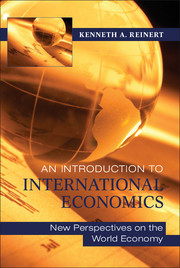Book contents
- Frontmatter
- Summary Contents
- Detailed Contents
- Preface
- Acknowledgments
- Acronyms
- Symbols
- 1 Windows on the World Economy
- I International Trade
- II International Production
- III International Finance
- IV International Development
- 20 Development Concepts
- 21 Growth and Development
- 22 International Production and Development
- 23 The World Bank
- 24 Structural Change and Adjustment
- Glossary
- Index
- References
20 - Development Concepts
from IV - International Development
- Frontmatter
- Summary Contents
- Detailed Contents
- Preface
- Acknowledgments
- Acronyms
- Symbols
- 1 Windows on the World Economy
- I International Trade
- II International Production
- III International Finance
- IV International Development
- 20 Development Concepts
- 21 Growth and Development
- 22 International Production and Development
- 23 The World Bank
- 24 Structural Change and Adjustment
- Glossary
- Index
- References
Summary
I once spoke with a Ghanaian student who had just taken his first course in international economics. He held a well-known book on globalization in his hand (I won't say which one) and was waving it at me. “Professor,” he asked with some agitation, “what does all this really mean for my country? We are going nowhere!” His question was a profound one, and it is shared by many, many individuals who have similar feelings about their countries’ relationships to the world economy. It is a question that we begin to answer in this part of the book on the fourth window on the world economy, international development. Stated another way, the question is: what can globalization, be it via international trade, international production, or international finance, do for the well-being of individuals around the world, particularly in those places where measures of standards of living are low, where a significant number of people are deprived in some significant respects?
We address this question in the five chapters making up this part of the book, beginning with this chapter on development concepts. It may seem funny that we are dedicating an entire chapter to concepts. We did not have a chapter on trade concepts! But it is appropriate because the notion of development is close to our notion of what is good and desirable for people, and it therefore takes some preliminary sorting out. So we begin by considering what we mean by development, taking up development as growth, development as human development, and development as structural change. Appendices to this chapter take up the relationship of gross domestic product and gross national income, as well as the Lorenz curve and Gini coefficient ratio, two measures of the degree of income inequality in an economy.
Information
- Type
- Chapter
- Information
- An Introduction to International EconomicsNew Perspectives on the World Economy, pp. 353 - 370Publisher: Cambridge University PressPrint publication year: 2011
